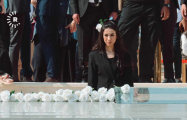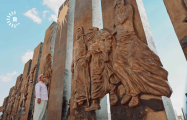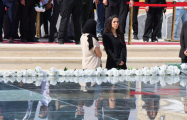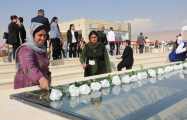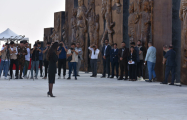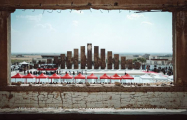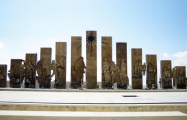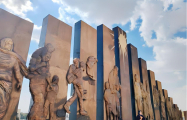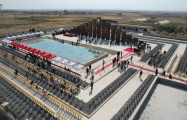Inauguration ceremony of the Yazidi genocide memorial was held in Iraq
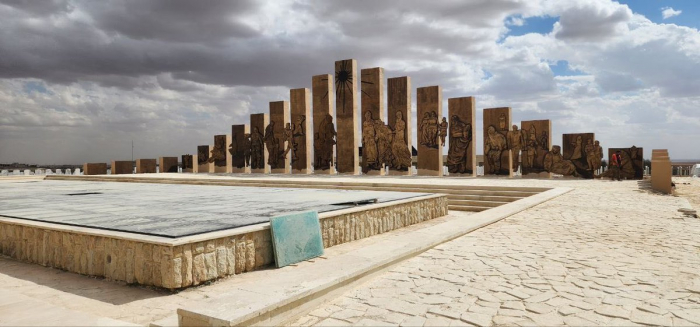
See photo below
The inauguration ceremony of the Yazidi Genocide Memorial was held in Sinjar, Iraq. The memorial was built by Nadia's Initiative in partnership with the International Organization for Migration in Iraq and funded by the United States Agency for International Development to commemorate the 2014 genocide.
The destruction of the Yazidi community was one of the most heinous atrocities of the 21st century. Not only were thousands of Yazidis murdered in cold blood in massacres, but ISIL proudly and publicly enslaved thousands of women through sexual violence and indoctrinated thousands of children.
The memorial serves as a reminder of the depths to which humanity can sink, and is a testament to the strength and resilience of the surviving Yazidi community as they rebuild their lives after genocide.
The memorial site includes the so-called "Mothers' Grave," the site where dozens of elderly Yazidi women were killed by ISIS terrorists nine years ago, including the mother of Yazidi activist and victim of ISIS terrorist atrocities, Nadia Murad, who opened the Yazidi Genocide Memorial with the words:
"The opening of this memorial is one step towards justice. However, our community will not be able to continue on the path to healing without additional help from the Iraqi authorities.
The construction of this memorial should not be the responsibility of the local community, just as the rebuilding of Sinjar should not be the sole responsibility of Yazidis and the international community.
We need more resources from the Iraqi government and we need regional stability so that displaced Yazidis can return home. I call on the governments of both Baghdad and Erbil to find a solution to the governance problem.
For Yazidis to rebuild their lives, we need to rescue the more than 2,000 women still in captivity. We need to continue exhuming mass graves and ensure that those who committed this genocide are held accountable in court for their actions. Until that happens, the Genocide Memorial will remain a mere reminder of our unbearable loss and suffering. However, I also want this moment to give our community hope that we can rebuild, heal and thrive again in Sinjar," - Nadia Murad.
ABOUT THE MEMORIAL:
The memorial complex welcomes visitors with a wall of 73 solar sculptures that represent 73 events of persecution of Yazidis recorded in their oral history. Rings of stone walkways girdle the 10,000 square meter area, symbolizing the timelessness and interconnectedness of the lives of the Yazidi community. Along the paths are nearly 3,000 unnamed gravestones honoring the more than 3,000 people who died in Sinjar during the 2014 Yazidi genocide.
At the center is an Olympic-sized pool that was originally designed as a fish breeding pond, in time for the ISIS attack in Sinjar, more than 90 elderly Yazidi women were found dead in the empty concrete pool. It is now called "Mothers' Grave" and has been preserved in pristine condition, covered by a tempered glass lid.
Above the "Tomb of Mothers" rises a monument of 25 concrete columns from 1 to 10 m high, forming a mountain shape, symbolizing the sacred mountain Sinjar. The tallest column depicts the sun, one of the most sacred symbols of Yazidism, representing birth and life. Along the columns are 25 sculptures depicting the Yazidi community on the move, reproducing real photos of the people who fled then in 2014 to safety.
The memorial was designed by Yazidi architect Dersim Khairy Namo using 3D imagery and is her gift to the community.
The construction of the site took about eight months and involved more than 60 workers from Sinjar. All materials were locally sourced, with much of the natural stone coming from Mount Sinjar. At every stage of construction, the victims themselves were also involved.
The Nadia Initiative organization purchased and donated the land with funds from the Nobel Peace Prize of founder and president Nadia Murad.
Tags:
Inauguration ceremony of the Yazidi genocide memorial was held in Iraq

See photo below
The inauguration ceremony of the Yazidi Genocide Memorial was held in Sinjar, Iraq. The memorial was built by Nadia's Initiative in partnership with the International Organization for Migration in Iraq and funded by the United States Agency for International Development to commemorate the 2014 genocide.
The destruction of the Yazidi community was one of the most heinous atrocities of the 21st century. Not only were thousands of Yazidis murdered in cold blood in massacres, but ISIL proudly and publicly enslaved thousands of women through sexual violence and indoctrinated thousands of children.
The memorial serves as a reminder of the depths to which humanity can sink, and is a testament to the strength and resilience of the surviving Yazidi community as they rebuild their lives after genocide.
The memorial site includes the so-called "Mothers' Grave," the site where dozens of elderly Yazidi women were killed by ISIS terrorists nine years ago, including the mother of Yazidi activist and victim of ISIS terrorist atrocities, Nadia Murad, who opened the Yazidi Genocide Memorial with the words:
"The opening of this memorial is one step towards justice. However, our community will not be able to continue on the path to healing without additional help from the Iraqi authorities.
The construction of this memorial should not be the responsibility of the local community, just as the rebuilding of Sinjar should not be the sole responsibility of Yazidis and the international community.
We need more resources from the Iraqi government and we need regional stability so that displaced Yazidis can return home. I call on the governments of both Baghdad and Erbil to find a solution to the governance problem.
For Yazidis to rebuild their lives, we need to rescue the more than 2,000 women still in captivity. We need to continue exhuming mass graves and ensure that those who committed this genocide are held accountable in court for their actions. Until that happens, the Genocide Memorial will remain a mere reminder of our unbearable loss and suffering. However, I also want this moment to give our community hope that we can rebuild, heal and thrive again in Sinjar," - Nadia Murad.
ABOUT THE MEMORIAL:
The memorial complex welcomes visitors with a wall of 73 solar sculptures that represent 73 events of persecution of Yazidis recorded in their oral history. Rings of stone walkways girdle the 10,000 square meter area, symbolizing the timelessness and interconnectedness of the lives of the Yazidi community. Along the paths are nearly 3,000 unnamed gravestones honoring the more than 3,000 people who died in Sinjar during the 2014 Yazidi genocide.
At the center is an Olympic-sized pool that was originally designed as a fish breeding pond, in time for the ISIS attack in Sinjar, more than 90 elderly Yazidi women were found dead in the empty concrete pool. It is now called "Mothers' Grave" and has been preserved in pristine condition, covered by a tempered glass lid.
Above the "Tomb of Mothers" rises a monument of 25 concrete columns from 1 to 10 m high, forming a mountain shape, symbolizing the sacred mountain Sinjar. The tallest column depicts the sun, one of the most sacred symbols of Yazidism, representing birth and life. Along the columns are 25 sculptures depicting the Yazidi community on the move, reproducing real photos of the people who fled then in 2014 to safety.
The memorial was designed by Yazidi architect Dersim Khairy Namo using 3D imagery and is her gift to the community.
The construction of the site took about eight months and involved more than 60 workers from Sinjar. All materials were locally sourced, with much of the natural stone coming from Mount Sinjar. At every stage of construction, the victims themselves were also involved.
The Nadia Initiative organization purchased and donated the land with funds from the Nobel Peace Prize of founder and president Nadia Murad.
Tags:
